WE RIDE BUD RACING’S KAWASAKI KX112 SUPERMINI
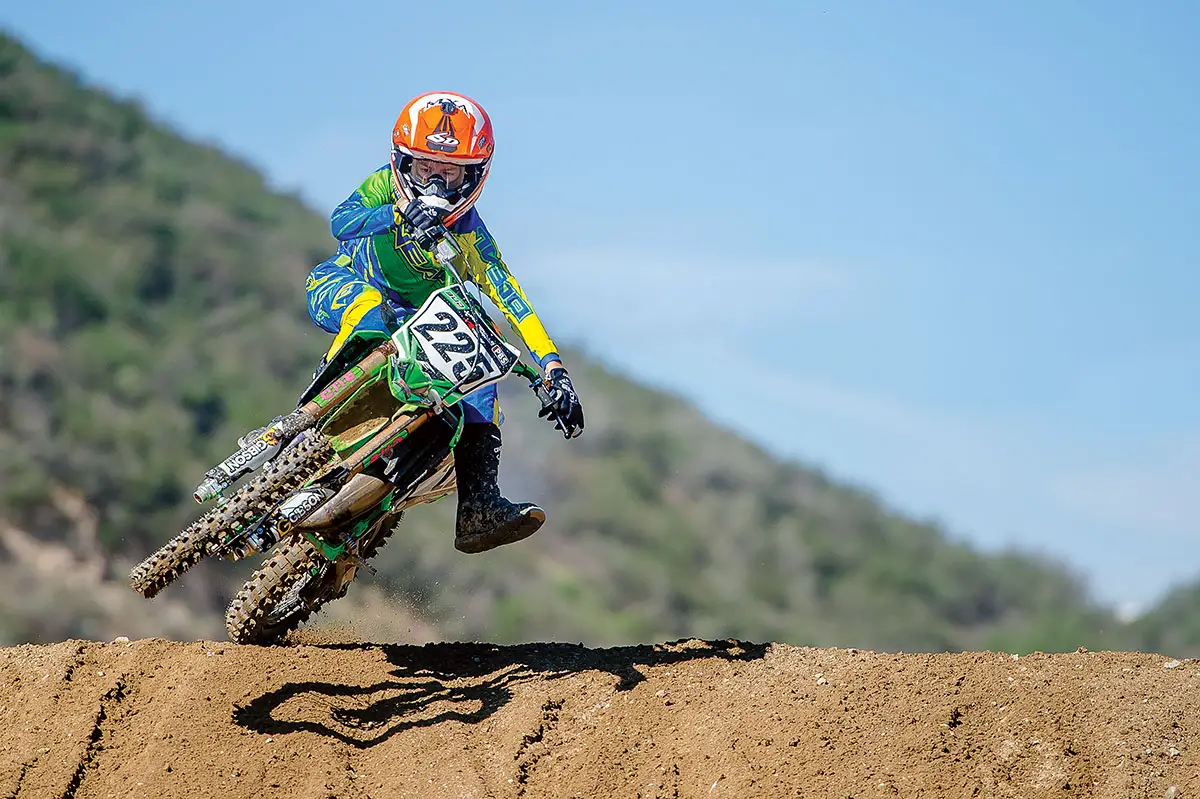 Designed to fill that awkward gap when Junior isn’t strong enough to manhandle a 250cc four-stroke, yet too big for an 85cc minicycle, the Bud Racing KX112 provides a stepping stone.
Designed to fill that awkward gap when Junior isn’t strong enough to manhandle a 250cc four-stroke, yet too big for an 85cc minicycle, the Bud Racing KX112 provides a stepping stone.
The absolute best thing about the Bud Racing Kawasaki KX112 Supermini is that it was built with a specific purpose in mind. This isn’t a garage queen, although it has more than enough cachet to put it way over the top in that category. Instead, it’s a race machine, but more than that, it is part of a comprehensive race program. The program takes young French minicycle riders and brings them up through the European EMX Championships and French Nationals, and eventually prepares them for a career in the MXGP or AMA Nationals.
“STEPHANE DASSE HAD AN EPIPHANY. INSTEAD OF MAKING HIS YOUNG CHARGES LEAP FROM A KAWASAKI KX85 TO A 250 FOUR-STROKE, HE WANTED TO TRY TO SMOOTH OUT THE LEARNING CURVE BY MAKING IT MORE GRADUAL.”
Bud Racing fields one of the largest motocross teams in Europe, and while its base is in France, it has a U.S. race shop in Elsinore, California. During this year’s AMA Supercross series, Bud Racing had Maxime Desprey racing in the 250 West and Cedric Soubeyras racing in the 250 East. As an official Kawasaki-supported race team, Bud Racing plays a big role in helping Kawasaki find new talent via an aggressive development program for up-and-coming French riders. Some notable names who have been a part of the Bud program are Marvin Musquin, Dylan Ferrandis, Xavier Boog, Meghan Rutledge and Brian Moreau.
Brian Moreau is a French minicycle sensation, and Bud Racing wanted to make sure that he had the best opportunity to transition from an 85cc minicycle up to the 250. That is when Bud’s owner Stephane Dasse had an epiphany. Instead of making his young charges leap from a Kawasaki KX85 to a 250 four-stroke, he wanted to try to smooth out the learning curve by making it more gradual. That led Bud Racing to build two very special machines. First is the Kawasaki KX112 that we are testing in this issue, and second is a special, hand-made, one-off Kawasaki KX250F with a 125cc two-stroke engine shoehorned into it. Interestingly, Bud Racing could not find a sufficient supply of discontinued Kawasaki KX125 two-stroke engines for the program, so even though Bud Racing is an official Kawasaki team, they put a Yamaha YZ125 engine into a Kawasaki KX250F frame. Brian Moreau will race it in the 2016 EMX 125 support class at this year’s GPs. You can find out more about it by Googling “Bud Racing’s Radical Aluminum-Framed KX125.”
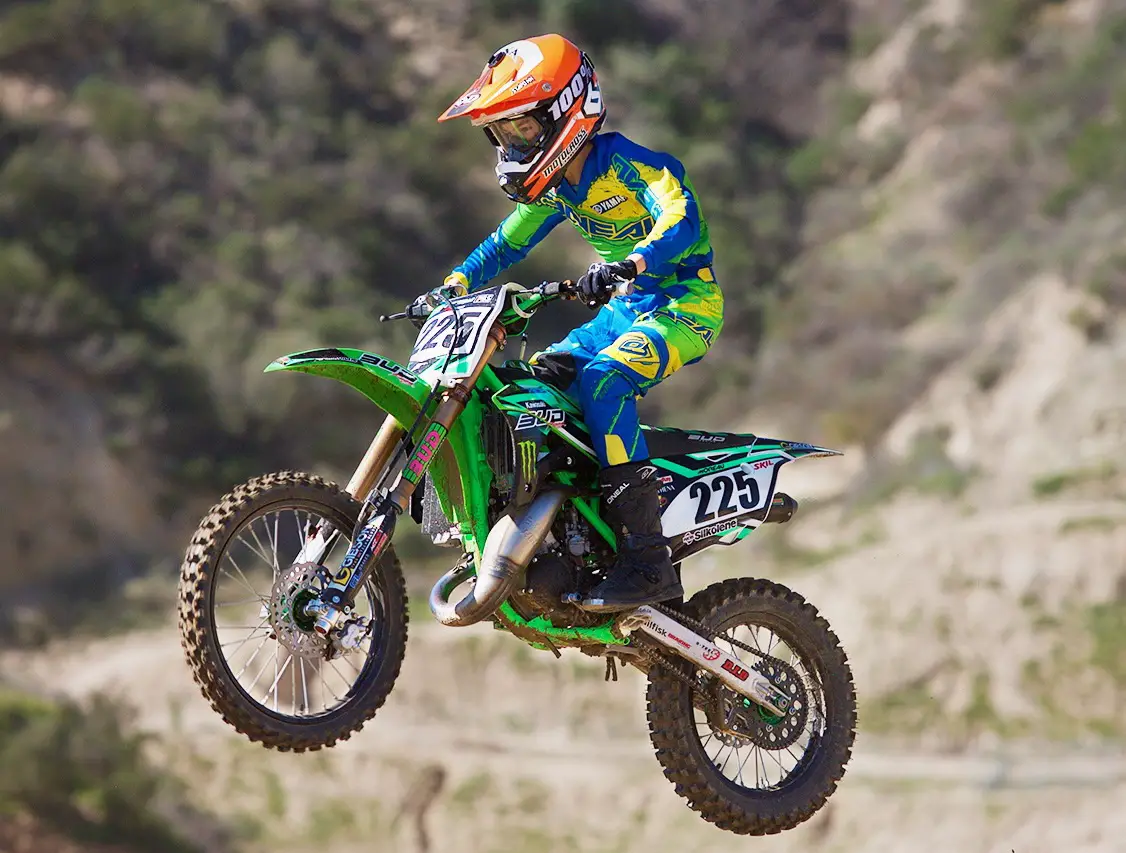
But let’s move on to the reason we are here: Bud Racing’s first step in the development ladder is the Kawasaki Supermini. This is such a special machine that just looking at it boggles the mind. Designed to move a rider out of the 85cc ranks in a stepped approach to power management, the KX112 bristles with exotica. From its Showa closed-cartridge forks to its Bud-built rear shock to its CNC-machined stroker crankshaft to its extra radiator to its potpourri of one-off accoutrements, this a Supermini without a price tag. Stephane Dasse’s goal was to build an 85cc-based engine with a powerband similar to that of a 125cc two-stroke—without the hindrance of the large size and heavy weight of a standard-issue 125 two-stroke. To that end, the Bud Racing KX112 can be used with either 17/14 minicycle wheels or 19/16 Supermini wheels.
“BUD RACING DEVELOPED A KIT THAT ENABLES HARD-CORE KX85 AND KX100 RACERS TO MOUNT A SECOND RADIATOR ON THEIR KAWASAKI KX85S.”
The biggest complaint over the years about the stock Kawasaki KX85 has been its lack of ponies—a situation made more aggravating by the plentiful power that the latest KTM and Husky 85s are pumping out. Bud Racing was able to start with a standard KX85 engine, which was last updated in 2014, and eliminate any doubt about who had the most horsepower. By boring and Nikasil-plating the cylinder out to 54.0mm and stroking the crank to 48.90mm, Bud Racing was able to create an engine that dwarfs the 48.5mm by 45.8mm bore and stroke of the showroom stock KX85. As if that weren’t enough, Bud modified the carb and installed special biaxial carbon fiber reed petals and its own exhaust system (with a carbon fiber silencer).
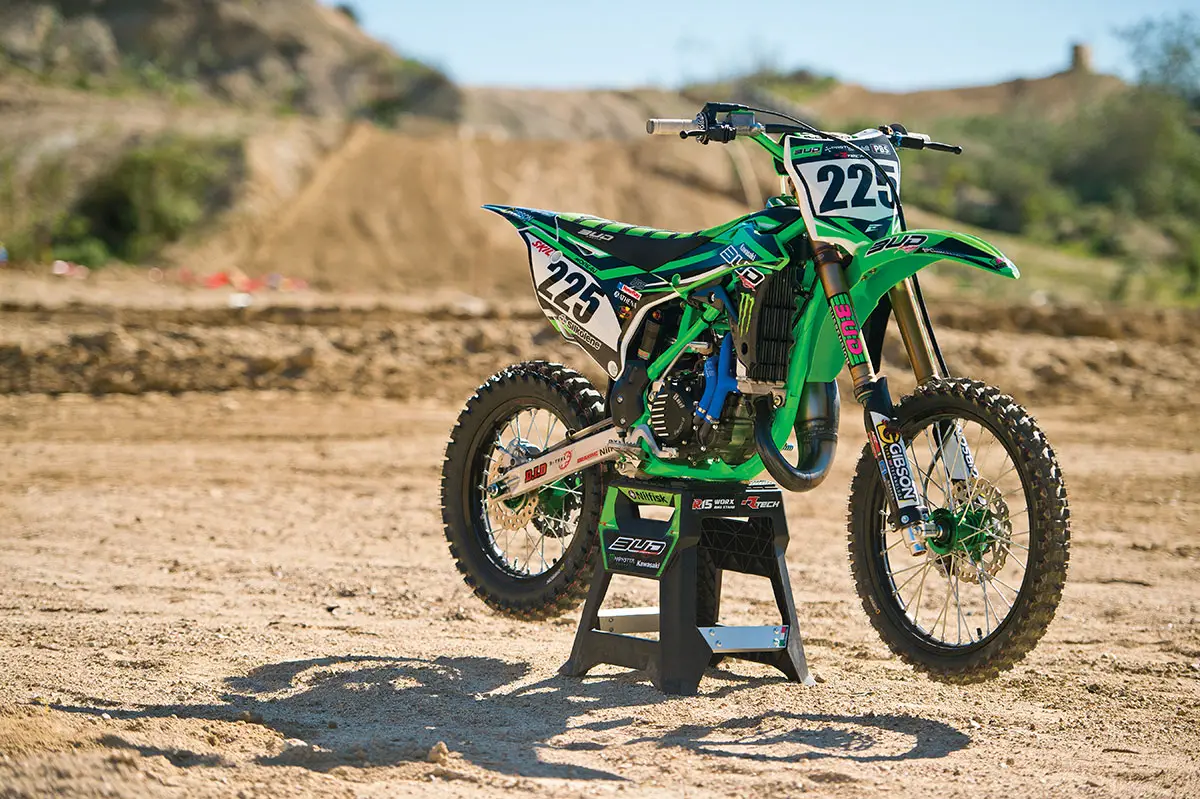
With the engine producing significantly more power, it was also generating a lot more heat. Bud tackled this with three innovations. First, Bud installed a cylinder head that not only had interchangeable combustion domes but also a larger water volume for more cooling. Second, a more hydrodynamic water-pump impeller was designed to up the gallon-per-minute capacity of the KX85’s pump. Third, Bud Racing developed a kit that enables hard-core KX85 and KX100 racers to mount a second radiator on their Kawasaki KX85s. The $429 kit includes the radiator, brackets, silicone hoses and special Bud exhaust pipe (with a different bracket to provide clearance for the extra radiator).
“I’M NOT FRENCH AND I’M NOT ON BUD RACING’S DEVELOPMENT TEAM, BUT I FEEL THAT MOVING FROM AN 85CC MINI TO A 112CC SUPERMINI TO A 125CC TWO-STROKE REALLY MAKES SENSE.”
Next on the agenda was the KX85 chassis. Given the high level of competition faced by its development team riders, Bud Racing didn’t want to leave anything to chance. The stock 36mm Kayaba forks were replaced with 37mm Showa forks with a closed-internal cartridge (like the factory forks of big bikes). The stock shock was thrown away and replaced with a complete Bud Racing shock with adjustable compression and rebound. The spring rate and valving are determined by each rider’s needs. The CNC machine was busy at Bud headquarters, as the KX112 featured milled triple clamps, CNC-machined hubs (laced to stronger rims with beefier spokes), 8mm-lower 7075-T6 footpegs, a machined clutch cover (your name can be engraved in it) and CNC-machined axle blocks. In addition to the reed petals and silencer being carbon fiber, the ignition cover and frame guards are also laid up.
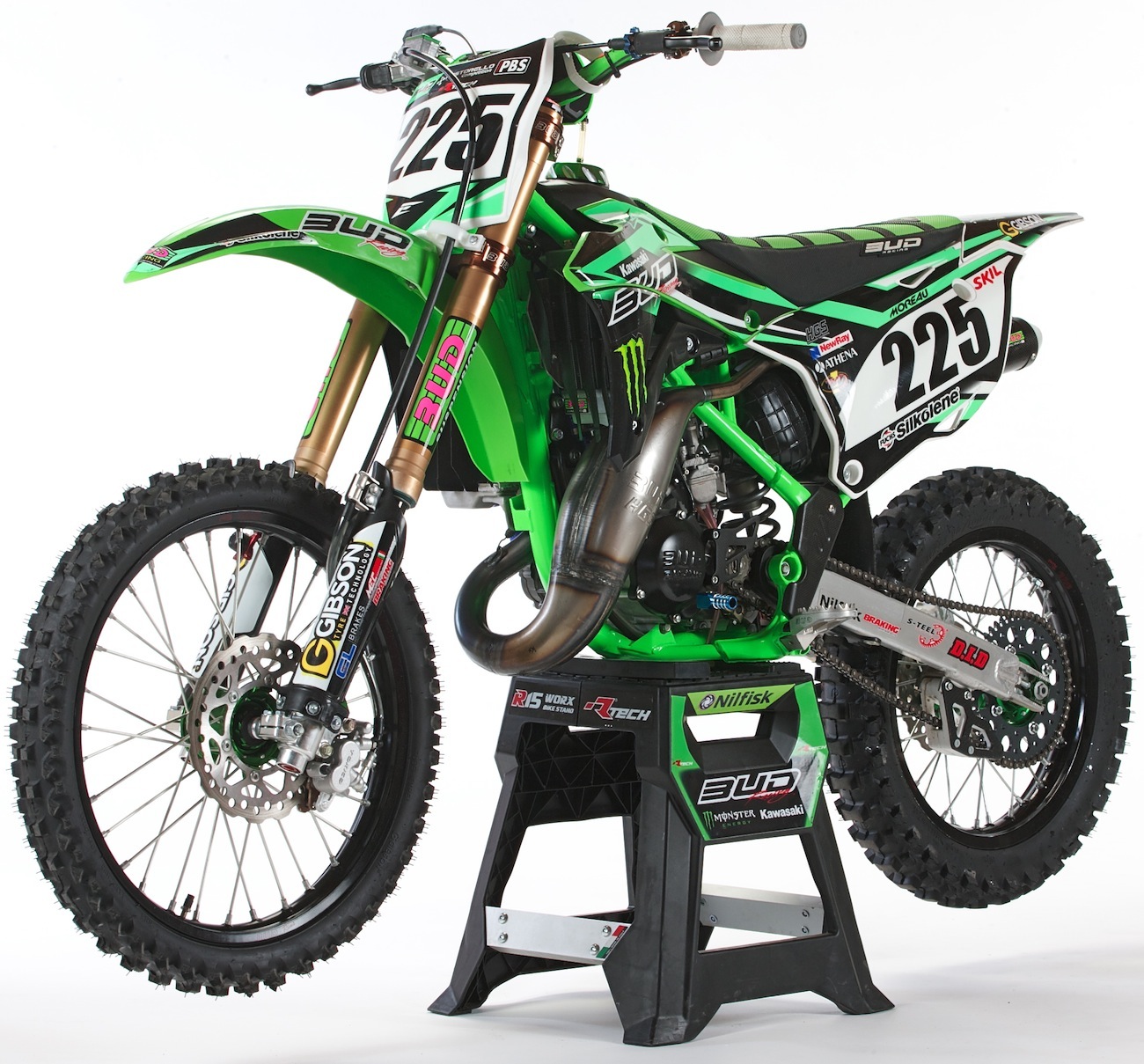 The final touches include a Bud Racing graphics kit, full-traction seat cover, adjustable clutch perch with Teflon ring, unbreakable front brake lever and Bud Racing shift lever, brake clamp, master cylinder cover, gearbox filler cap and gas tank cap.
The final touches include a Bud Racing graphics kit, full-traction seat cover, adjustable clutch perch with Teflon ring, unbreakable front brake lever and Bud Racing shift lever, brake clamp, master cylinder cover, gearbox filler cap and gas tank cap.
When MXA’s minicycle test rider Carter Dubach climbed on board, the first thing he noticed was how stiff the suspension was. “The suspension felt stiff right off the bat. I made several trips back to the pits to make adjustments. I took some preload off the rear shock spring and opened up the clickers. Since this bike was set up for French minicycle Champion Brian Moreau, who will be moving to the EMX 125 Two-Stroke Championship this year, it was dialed in for a rider who is much heavier and taller than I am. But, I kept adjusting the ride height and clicker settings until I found a balance that worked well. Every time I went out on the track I could feel that the shock and fork damping were good, especially at the bottom of Glen Helen’s two big downhills, where the giant braking bumps ate up travel. For my weight I’d just need to go down a spring rate on the shock.”
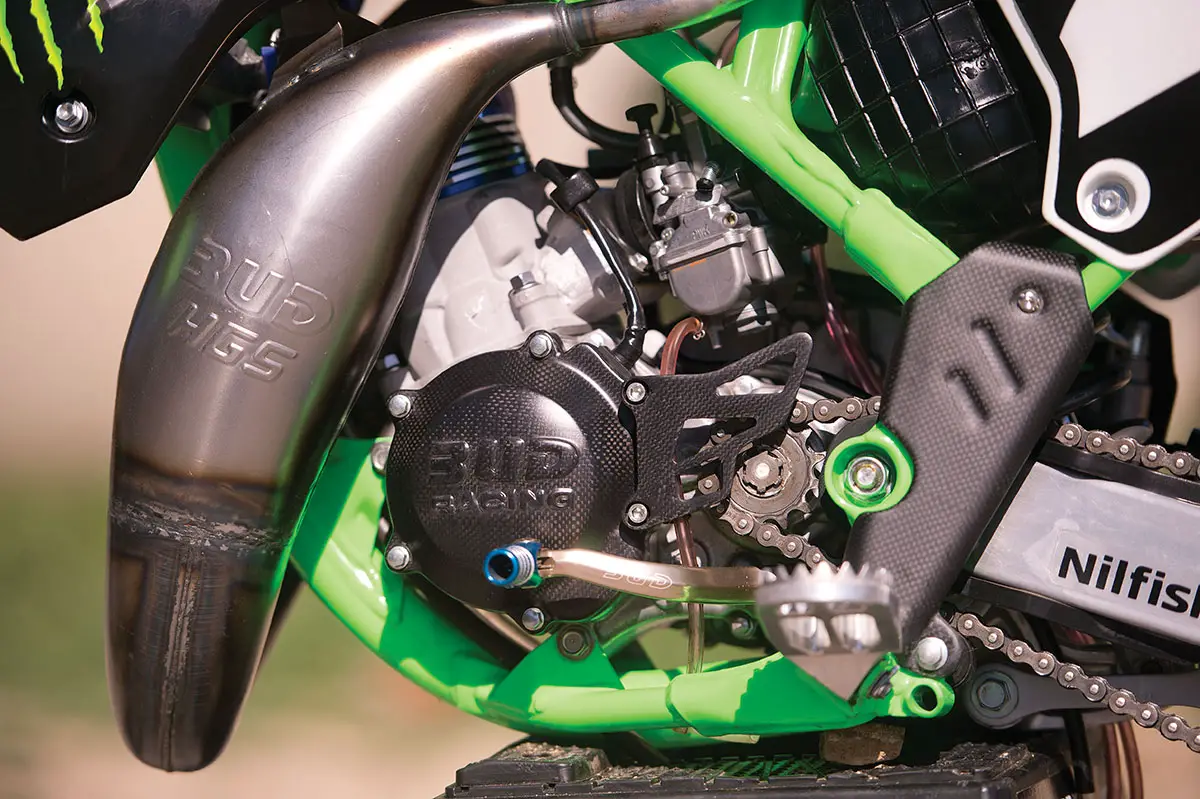 Thanks to a massive piston and a stroker crank, the Bud Racing KX112 needs the added cooling of a second radiator.
Thanks to a massive piston and a stroker crank, the Bud Racing KX112 needs the added cooling of a second radiator.
As for how the Bud Racing KX112 ran, Carter said, “Walking up to the bike, my first thought was, wow, this is a cool bike. But since you can’t judge a book by its cover, I knew that riding it would be the proof in the pudding. It was a warm day at Glen Helen, and the track was rough and rutted as usual. As I entered the track and headed down the long start straight into the Talladega first turn, I thought, this thing is amazingly fast. It pulled hard and revved fairly high. On the tighter parts of the track I really needed to keep the powerband up in the revs. It wasn’t bogging; it just took more attention to get the most out of the powerband. With each and every lap—and suspension adjustment—I got more comfortable with the massive increase in power. This isn’t a Novice engine. It requires that the rider pay attention to the revs and have Intermediate-and-up talent to keep it on the pipe. I’m not French, and I’m not on Bud Racing’s development team, but I feel that moving from an 85cc mini to a 112cc Supermini to a 125cc two-stroke really makes sense, especially for smaller riders who are not prepared for a 224-pound 250 four-stroke.”

Some of the parts on the Bud Racing KX112 are unobtainable, but you can access many of the parts and accessories by going to www.budracing-usa.com or calling (951) 245-2660.


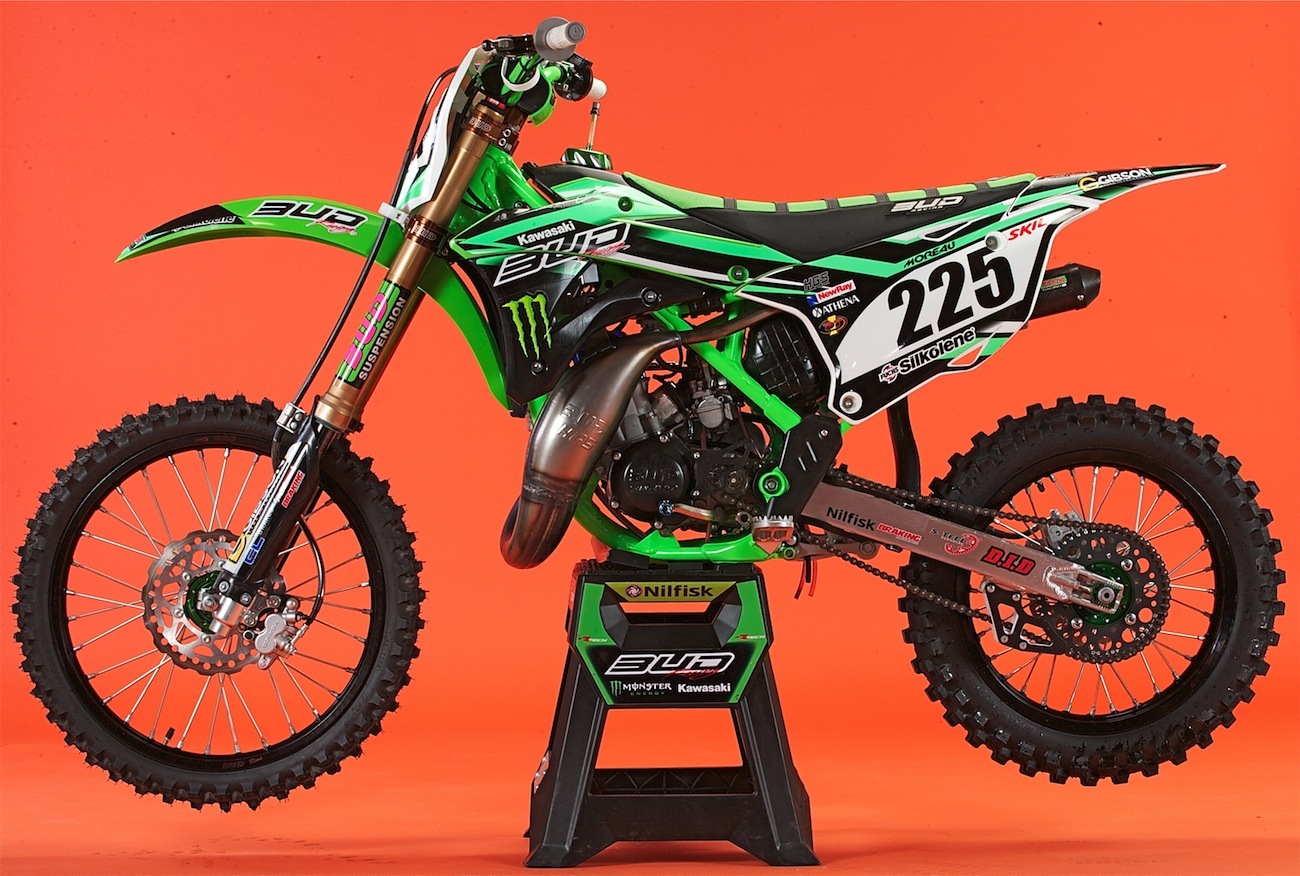





Comments are closed.